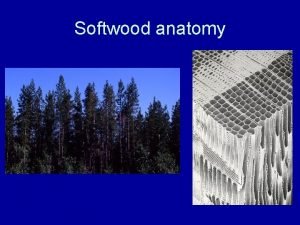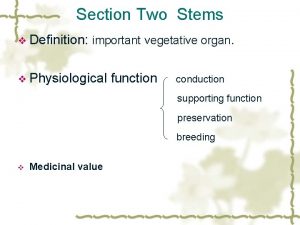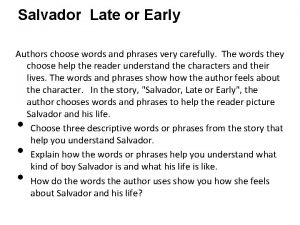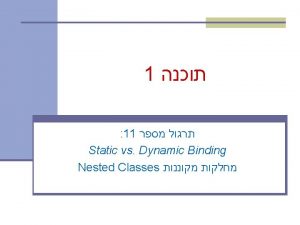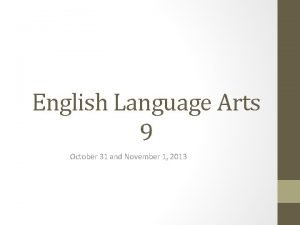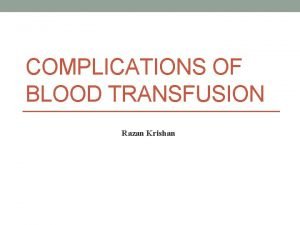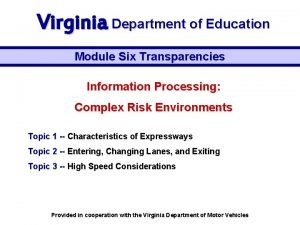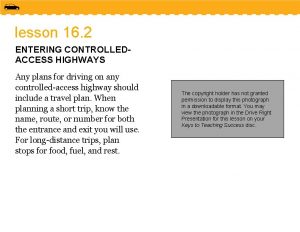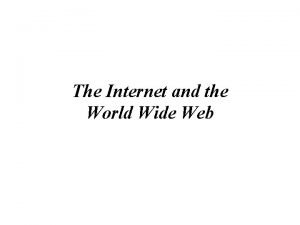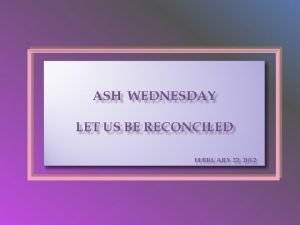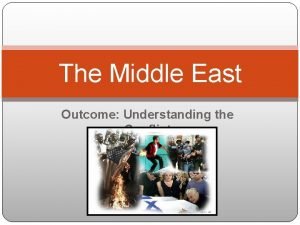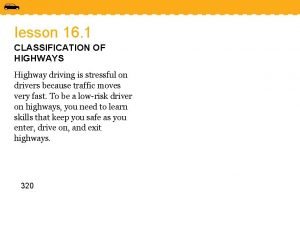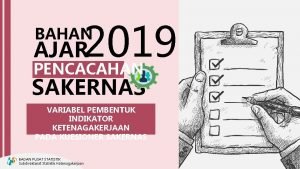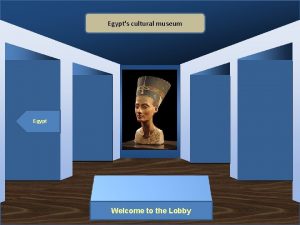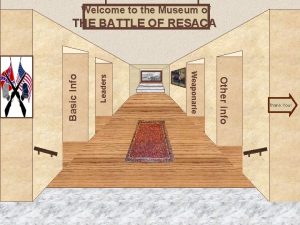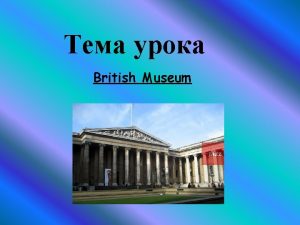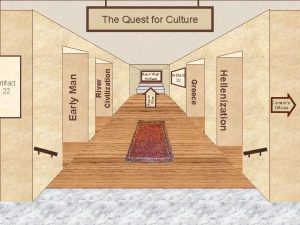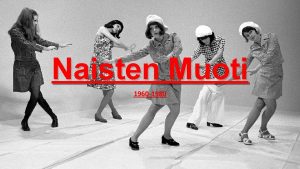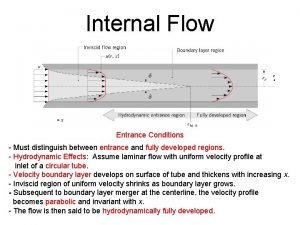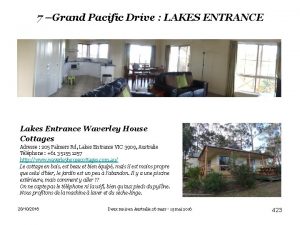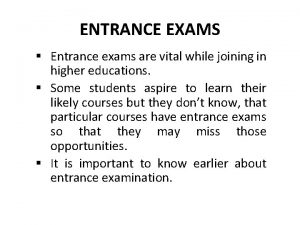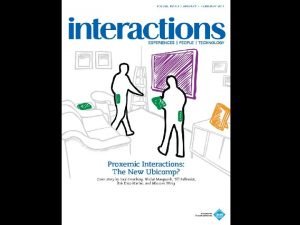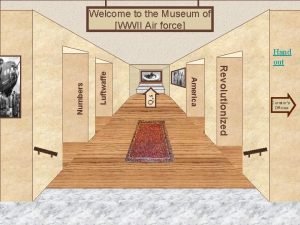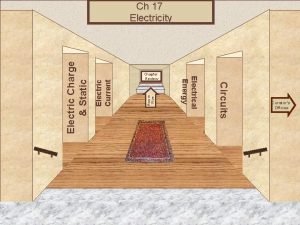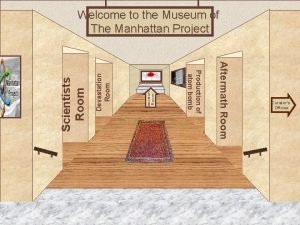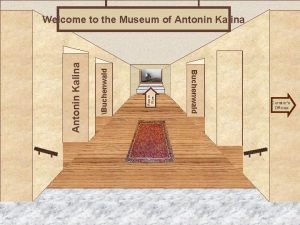Early 1960 s Museum Entrance Late 1960 s






















- Slides: 22

Early 1960 s Museum Entrance Late 1960 s Mid 1950 s Welcome to the Museum of The Cold War Curator’s Offices

Maddie Westrup Curator’s Office Hello, I’m Maddie. I attended NYU majoring in history. My favorite time in history was the Cold War due to all the memorable events in the era, good and bad. 0001038235@students. ccisd. net Return to Entry Note: Virtual museums were first introduced by educators at Keith Valley Middle School in Horsham, Pennsylvania. This template was designed by Dr. Christy Keeler. View the Educational Virtual Museums website for more information on this instructional technique.

Mid 1950 s Room 1 Return to Entry

Early 1960 s Room 2 Return to Entry

Mid 1960 s Room 3 Artifact 10 Return to Entry

Late 1960 s Room 4 Return to Entry

Khrushchev and the Twentieth Congress of the Communist Party The Khrushchev and the twentieth congress of the communist party began when Soviet leader Nikita Khrushchev used his speech to maintain the communists. With this occurring in 1956 the speech was supposed to become the opening slavo in a larger effort. Linked citation goes here Return to Exhibit “Office of the Historian. ” Office of the Historian. N. p. , n. d. Web. 21 Apr. 2014

Bi-Polar Foreign Policy Concern of the spread of communism and the rapidly developing power of the Soviet Union cause US foreign policy maker to grasp a tighter hold on Europe. President Eisenhower supported a doctrine of massive retaliation. With this lasting from 1953 -1960 this served to allow the foreign policymaking power of the presidency and to expand U. S. international obligations. “Office of the Historian. ” Office of the Historian. N. p. , n. d. Web. 21 Apr. 2014 Return to Exhibit

The Suez Crisis began all when Egyptian president Gamal Abdel Nasser announced the nationalization of the Suez canal company. Three countries were involved being Egypt, Britain, and France. This war was an attempt for one of the involved countries to take ownership of the canal. This occurred in 1956. “Office of the Historian. ” Office of the Historian. N. p. , n. d. Web. 21 Apr. 2014 Return to Exhibit

Sputnik was the words first satellite launched by the Soviet Union marking the start of the international space race. Sputnik did increase Cold War tensions occurring in 1957. Office of the Historian. ” Office of the Historian. N. p. , n. d. Web. 21 Apr. 2014 Return to Exhibit

The Eisenhower Doctrine Under the Eisenhower doctrine a country could request American economic assistance and/ or aid from U. S. military forces if it was being threatened by another state. This doctrine targeted the Soviet Union, in which occurred in 1957. This was the attempt to try and weaken The Soviet Ocean. “Office of the Historian. ” Office of the Historian. N. p. , n. d. Web. 21 Apr. 2014 Return to Exhibit

The Berlin Crisis started after Khrushchev made a speech stating that the western powers of the United States, Great Britain, and France pull their forces out of West Berlin within 6 months. A 3 year crisis them resulted in this, in which Berlin built up the Berlin wall in which stayed up for 3 years. With both sides of Berlin having a different type of government. Finally, on November 9 th, 1989 the “Office of the Historian. ” Office of the Historian. N. p. , n. d. Berlin Web. 21 Apr. wall 2014 was destroyed. Return to Exhibit

U-2 Over flights and the Capture of Francis Gary Powers Occurring on May 1 st, 1960 the American U-2 spy plane was shot down while flying through Soviet airspace. Nuclear capabilities has been a major concern for the Soviet Union and the U. S. for a while now. The spy plane was sent to observe the Soviet Unions progress with nuclear weapons and to notify the U. S. on what to be prepared for. “Office of the Historian. ” Office of the Historian. N. p. , n. d. Web. 21 Apr. 2014 Linked citation goes here Return to Exhibit

The Congo, Decolonization, and the Cold War With nonaligned nations piling up during the Cold War the Soviet Union and the U. S wanted these countries to take their sides. One of the first countries to experience this was the former Belgian Congo. Unfortunately the Congo grew chaotic shortly after gaining its independence on June 60, 1960. The nonaligned nations created more conflict with the U. S and Soviet Union, in which each fought for those countries to go on their side and follow their form of “Office of the Historian. ” Office of the Historian. N. p. , n. d. government and to create a larger Web. 21 Apr. 2014 and stronger military force for that superpower. Linked citation goes here Return to Exhibit

The Bay of Pigs Invasion The Bay of Pigs invasion consisted of the United States not agreeing with Castro’s ways. This caused an invasion on Cuba. First the U. S. got the CIA to plan the invasion. The U. S. invaded Cuba at The Bay of Pigs in which they faced an embarrassing defeat 2 days later. “Office of the Historian. ” Office of the Historian. N. p. , n. d. Web. 21 Apr. 2014 Return to Exhibit

The Cuban Missile Crisis After the U. S. attempt of invading Cuba, Cuba made a secret agreement with the Soviet Union. Soviet nuclear missiles were placed in Cuba to avoid any future invasion attempts. After the United States found out about this the tension of a nuclear was tighter than ever. The U. S. and the Soviet Union them came to an agreement in which promised the U. S. wouldn’t invade Cuba as long at the Soviet Union took down the missiles. This lasted from 1961 -1968. “Office of the Historian. ” Office of the Historian. N. p. , n. d. Web. 21 Apr. 2014 Return to Exhibit

The U. S. Involvement in the Vietnam War The Vietnam war from 1961 -1968 was a conflict between North Vietnam and South Vietnam. With North Vietnam heavily defeating South Vietnam the United States felt they needed to step in to help South Vietnam. Two U. S. destroyers were placed in the Gulf of Tonkin only to be fired on by North Vietnam. The U. S. solution to win the war was to keep recruiting more U. S. soldiers. Soon the U. S. had forces all over Southeast Asia. As a resolution to weaken Hanoi, President Johnson and his advisers ordered the U. S. Office military to launch “Office of the Historian. ” of the Historian. N. p. , n. d. operation Rolling Thunder, which Web. 21 Apr. 2014 was a bombing campaign against the North. Return to Exhibit

The India-Pakistan War of 1965 In 1965 the second war between India and Pakistan broke out. This was caused both superpowers, the United States and the Soviet Union to step in. The dispute over this region originated in the process of decolonization in South Asia. The conflict was territorial. Pakistan was made up of 2 noncontiguous regions, East Pakistan and West Pakistan, separated by Indian territory. The state of Jammu and Kashmir shared borders with both India and West Pakistan. The argument over which nation would incorporate the state led to the first India-Pakistan war inofwhich lasted “Office of the Historian. ” Office the Historian. N. p. , n. d. from Web. 211947 -1948. Apr. 2014 Return to Exhibit

The 1967 Arab-Israeli War The Arab-Israeli Conflict involved the United States, United Kingdom, and France in which they had pledged to prevent aggression by Middle Eastern states and oppose a regional arms race. In 1957, President Eisenhower had promised that the United States would treat the closure of the Straits as an act of war. Johnson now had 3 unwelcome options: to renege on attack on Egypt, or order U. S. forces “Office of the Historian. ” Office of the Historian. N. p. , n. d. to reopen the waterway. Web. 21 Apr. 2014 Return to Exhibit

The U. S. Involvement in the Vietnam War: The Tet Offensive In late January, 1968, during the lunar new year holiday, North Vietnamese and communists Viet Cong forces launched a coordinated attack against a number of targets in South Vietnam. The U. S. and South Vietnamese militaries sustained heavy losses before finally repelling the communist assault. The Tet Offensive played an important role in weakening U. S. public support for the war in Vietnam. “Office of the Historian. ” Office of the Historian. N. p. , n. d. Web. 21 Apr. 2014 Linked citation goes here Return to Exhibit

Soviet Invasion of Czechoslovakia On August 28, 1968, the Soviet Union led Warsaw Pact troops in an invasion of Czechoslovakia to crack down on reformist trends in Prauge. The Soviet invasion on Czechoslovakia was significant in the sense that it delayed the splintering of Eastern European Communism and was concluded without provoking any direct intervention from the West. “Office of the Historian. ” Office of the Historian. N. p. , n. d. Web. 21 Apr. 2014 Return to Exhibit

The Nuclear Non-Proliferation Treaty was an agreement signed in 1968 by several of the major nuclear and non- nuclear powers that pledged their cooperation in stemming the spread on nuclear technology. The treaty was signed by the United States and the Soviet Union. “Office of the Historian. ” Office of the Historian. N. p. , n. d. Web. 21 Apr. 2014 Return to Exhibit
 Late latent syphilis
Late latent syphilis Softwood anatomy
Softwood anatomy Salvador late or early theme
Salvador late or early theme Early vs late wood
Early vs late wood Bell stage of tooth development
Bell stage of tooth development Roots vegetative propagation
Roots vegetative propagation Early and late complications of blood transfusion
Early and late complications of blood transfusion Easter happens around the same time as passover
Easter happens around the same time as passover Salvador late or early analysis
Salvador late or early analysis Static binding example
Static binding example Arti kale
Arti kale Salvador late or early answer key
Salvador late or early answer key Blood transfusion complications
Blood transfusion complications Early cpr and early defibrillation can: *
Early cpr and early defibrillation can: * The merging area of an entrance ramp is marked by
The merging area of an entrance ramp is marked by Prayer meeting
Prayer meeting Highway with short entrance lane
Highway with short entrance lane An organization providing an entrance ramp to internet
An organization providing an entrance ramp to internet Entrance antiphon for today's mass
Entrance antiphon for today's mass Rvh atrium entrance
Rvh atrium entrance Entrance hidden by bricks and rubble
Entrance hidden by bricks and rubble Controlled-access highway
Controlled-access highway Kuesioner sakernas 2019
Kuesioner sakernas 2019

